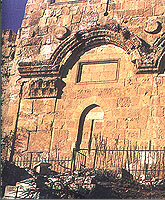|

Early Islamic Cemeteries in Jerusalem
|
It seems that the Muslim custom of burying the dead in areas north and east of the city walls was introduced in the tenth century CE. This choice of burial grounds probably reflects theological beliefs concerning the last judgment and resurrection connected to the Mount of Olives and the Asihara area (north of Herod's Gate). |
|
Along the eastern wall of the Temple Mount remains of a Muslim cemetery can be found to this day. The northern cemetery is located in the area of the Third Wall of the Second Temple period (north of the Damascus Gate). In another cemetery, located in the Mamilla Pool area, there are the burials of the victims of the Persian invasion of 614 CE. |
|
A unique group of some 30 graves was unearthed near Robinson's Arch, at the southwest corner of the Temple Mount. These graves were dug into earthen fills, which had accumulated along a stretch of some 50 m between the western wall of the Temple Mount and one of the Umayyad 'palaces' (Palace IV). Among the deceased were women, children and men of different ages. The bodies were interred in the Muslim tradition: on the side, oriented east-west and facing south. It is possible that some of the interred had originally been buried in wooden coffins, as evidenced by some iron nails that had survived; this, however, is not in accord with the Muslim tradition. As burial goods are lacking the dating of these burials is difficult. Nearby are the remains of a small prayer house (Musalla) accommodating a water basin for purification. A massive wall, thought to be the Crusader-period city wall, runs above this area. Excavations in the vicinity of the graves unearthed Arabic burial inscriptions, which were probably part of the same cemetery. |

|


